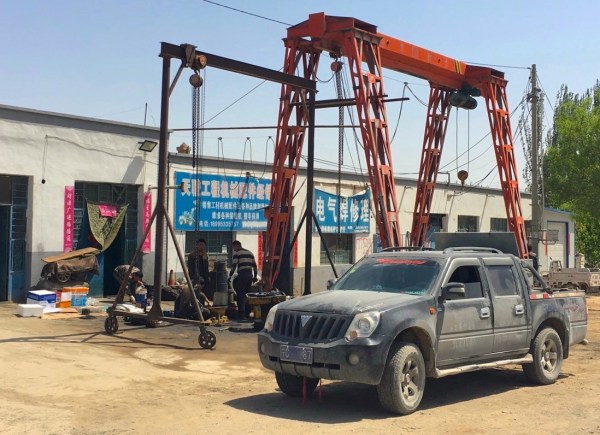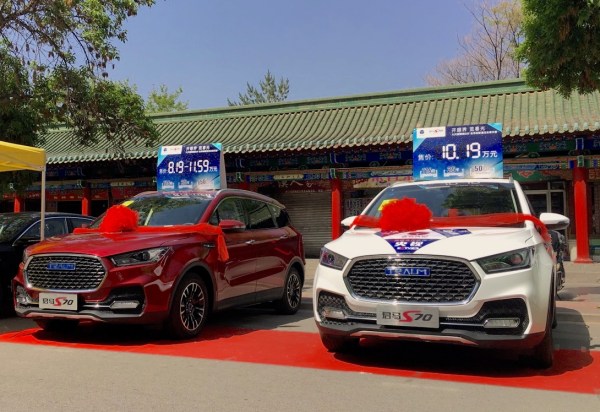China 2018 Photo Reports: The cars (and LSEVs) of Zhongwei, Ningxia
 Outstanding local snacks and LSEVs: that’s the Zhongwei vibe for you.
Outstanding local snacks and LSEVs: that’s the Zhongwei vibe for you.
This is Part 9 and the last iteration of our 2018 China exploration. You can check out Part 1: The cars of Beijing and using the Didi app here, Part 2: Renting a car in China here, Part 3: The cars of Yinchuan, Ningxia province here, Part 4: The cars of Bayanhot, Inner Mongolia here, Part 5: The Gobi and Tengger deserts here, Part 6: The cars of Alashan Youqi, Inner Mongolia here, Part 7: The Badain Jaran desert here and Part 8: The cars of Jiayuguan, Gansu province here. For this last section we are headed back east towards Yinchuan where I must return my rental VW Lavida, and we stop on the way in Zhongwei in the Ningxia province, a full day, 750km (466mi) southeastern drive. Yinchuan is then a quick 200km (125mi) north.


 After a near-miss, a providential servo and a Zhongwei hotel not quite used to English yet.
After a near-miss, a providential servo and a Zhongwei hotel not quite used to English yet.
But first, drama almost strikes just before I arrive in Zhongwei after nightfall. Incorrect highway signage announcing one last petrol station that ended up not being completed yet means I almost run out of fuel after exiting the highway, as the “Around me” app on my phone failed me not once, but twice, leading me to venues where the actual petrol stations had long closed down and gone bust. So between the servos that weren’t there just yet, and the ones that had disappeared by the time I arrive, I watched the “Refuel soon” alarm on my rental Lavida go from a casual ICYMI alert to a “drop everything and feed me!” scream that monopolised my dashboard screen and anxiously wondered how many additional km I was allowed to drive “dry”. It all ended well with a providential servo inside Zhongwei.


 Cars in the Shapotou parking lot included a yellow BAW Jeep and a pink VW Sagitar.
Cars in the Shapotou parking lot included a yellow BAW Jeep and a pink VW Sagitar.
Shapotou is the reason why I stopped in Zhongwei. On paper, it sounds like a fantastic place: 17km (11mi) west of town, it lies on the fringes of the Tengger Desert at the dramatic convergence of sand dunes, the yellow river and lush farmlands. But in reality it’s a tourist circus with zip lines, overcrowded rafting “boats” and off-road buggy rentals. Very far from the calm and serenity of the Badain Jaran desert we visited a couple of days ago. I don’t stay long, and choose instead to snap pictures of the most interesting cars parked in the gigantic tourist parking lot.


 Foton SUP, Great Wall Wingle 6 and Wuling Mini Truck in Zhongwei.
Foton SUP, Great Wall Wingle 6 and Wuling Mini Truck in Zhongwei.
Although it is home to 1.041.821 inhabitants, Zhongwei remains a Tier 4 city – see an excellent Tier calculation explanation and complete map of all Chinese cities by the South China Morning Post here. This means a few things in terms of car landscape: Chinese carmakers have a strong dealership network here, local crossovers fuel the national surge we have seen in the past 5 years, pickup trucks remain the surefire choice in town and the most popular foreign manufacturers are the ones offering affordable options, not the premium Germans dominant in the largest cities such as Beijing and Shanghai.


 Zhongwei taxis are mainly Skoda Rapid and VW Jetta.
Zhongwei taxis are mainly Skoda Rapid and VW Jetta.
We are now definitely back into civilisation with a large town and a strong need for cheap public transportation. The taxis are mainly Skoda Rapid – a first in the Chinese towns I have visited so far – and VW Jetta, and the Wuling Hongguang and other mini- and microvans are back atop the sales rankings, as is the Wuling Mini Truck whose popularity never really faded during this 2018 exploration, except in Bayanhot.

 Nissan Kicks and Lifan Myway in Zhongwei
Nissan Kicks and Lifan Myway in Zhongwei
As expected local crossovers have convinced many buyers in town, with the Geely Vision SUV once again among the favourites – it has been in every city I visited, the FAW Besturn X40 being one other notable success here. The VW Bora is the favourite sedan in Zhongwei and the Chevrolet Cavalier has already established itself solidly here. Venucia as a brand is also strong here.


 Red carpet for Traum and Geely at the mini Zhongwei pop up Auto Show…
Red carpet for Traum and Geely at the mini Zhongwei pop up Auto Show…
But without a doubt the most interesting element of my Zhongwei visit is the mini pop up Auto Show that suddenly appeared in one of the town’s main street on the morning of my departure, complete with street food vendors – notably one of the local delicacies, a delicious spicy tofu. There were “traditional” carmakers, and the list is telling for a Tier 4 city such as Zhongwei: Traum, a new brand by Zotye which wasn’t at the Beijing Auto Show, and Geely the current #1 Chinese brand at home.


 One of the main streets of Zhongwei was transformed into a mini pop up Auto Show when I visited.
One of the main streets of Zhongwei was transformed into a mini pop up Auto Show when I visited.
However to me the most interesting element of this pop up Auto Show is the dominating presence of LSEV carmakers (Low-Speed Electric Vehicles). And it’s a great opportunity for us to start covering LSEVs on BSCB. Sales of LSEVs in China surged 79.1% from 688.000 units in 2015 to 1.232 million in 2017 and probably over 1.5 million in 2017, but these sales aren’t covered in the monthly statistics we publish on BSCB as these vehicles, which don’t require a driver licence to be operated, are not considered “real” cars. With a top speed traditionally limited to 50 to 60km/h (30-35 mph), LSEVs are not authorised to leave the city centres.

 Yogomo 330, X350 and Han Tang brochure
Yogomo 330, X350 and Han Tang brochure
Absent from the largest cities in the country, LSEVs are more and more frequent in smaller towns such as Alashan Youqi. Clearly, Zhongwei had been deemed a perfect breeding ground for LSEVs judging by their overwhelming presence in this pop up Auto Show. Note our Exclusive Guide does not currently include LSEV carmakers as it would add a staggering 50+ brands to the 174 currently active, but we do keep a close eye on LSEV makers as at least four of them have already “graduated” to so-called high-speed EVs such as Levdeo, Senyuan, Yogomo through the YGM brand and Zuojun.
Among the LSEV carmakers present at the Zhongwei pop up Show were Levdeo which seems to stand out as one of the leaders in the category, showing its D70 hatch but also its V60 sedan and S50 crossover which aren’t LSEVs but high-speed EVs, Yogomo showing off its 330 and X340 hatches, Baoya propping no less than three examples of the Yabei. Here is the list of the 54 LSEV makers we have been able to compile to date: AGSEV, AIMA, Baoya (宝雅), Bidewen, Bodo, BYVIN, Conors, Dayang, Dexing, Dojo, Entu, Fulu, Henghe Fuxing, Hongdi, Hongri, Inmax, Jiayuan, Jijie Tule, Jingcai, Jinpeng, Jinxiang, Kaiyun, Levdeo, Lewei, Lichi, Lishededidong, Longqi, Luxing, Qianli, Qifeng, Qingqi, Rainchst, Rattle, Reiters, Sendi, Senyuan, Shaolin, Shenghao, Shifeng, SUNRA, Tieke, Today, T.R.P, Weikerui, Xinyuma, Xinyuzhou, Xuanyu, Xuzhou, Yadea, Yogomo (御捷), Zhonghui, Zhongjue, Zhongxin and Zuojun.
 The Haval H6 is one of the cars I was able to test drive in Yinchuan before flying back to Australia.
The Haval H6 is one of the cars I was able to test drive in Yinchuan before flying back to Australia.
In the few hours I have between my return in Yinchuan and my flight back to Beijing I managed to test drive the Baojun 510, Haval H6 and Geely Boyue. See the Test Drive reports and videos here. We end the trip with my rental VW Lavida displaying 31.021 km on the odo, that’s 2.565 km (1.593 mi) in 6 days in what will remain my very first driving adventure in China, and hopefully the first of many to come. If you are wondering how it is possible to rent a car and drive (almost) anywhere in China as a foreigner, all the steps to do so are here. I hope you enjoyed exploring the lesser known parts of China with me this year, it’s over for this year but we will take it where we left it in 2019 for the Shanghai Auto Show. 谢谢你,再见! Xiexie Ni, Zaijian! Thank you and good bye!






Hi,
Thanks for an interesting report. A few questions, if you should have the time:
1. How many brands would you roughly estimate have dealerships almost all over China?
2. Are all Chinese pick-ups (those with a snout, like Foton SUP) 4-doors? Never seems to be any 2-doors on the photos.
Regards, Trond, Oslo
Dear Trond,
Many thanks for your comment.
1. As you can verify in our Exclusive Guide to All Chinese brands, there are currently 174 active Chinese brands operating in China, added to this over 50 LSEV brands and roughly 60 to 80 foreign brands and you come close to 300 brands in China. Of course none of them have dealerships all over China, and it’s very difficult to estimate which brands have the largest coverage. But to be safe I’d say roughly 100 brands have a very dense dealership network currently and half of them are Chinese.
2. Yes Chinese pickups are mostly sold as double cab 4×4. single cabs are extremely rare and almost non-existent in China.
All the best,
Matt
Thanks!
Trond